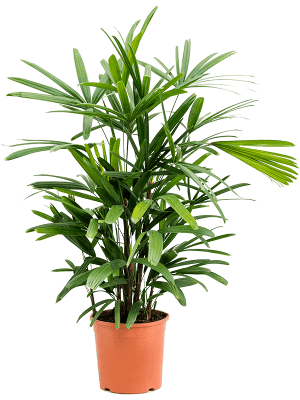
Rhapis excelsa (80-100)
Tuft
4RHEXBU07
The lush Rhapis is an asset to any interior with its fan-shaped, deeply slashed leaves that grow from multiple stems. This palm species is one of the best plants for purifying the air, and as a true shade plant, it can stand a bit of darkness. It's also easy to maintain. It's no surprise that the Rhapis is a favourite in the office!
Because of the special trunks that resemble bamboo (sticks), the Rhapis palm is also called bamboo palm, stick palm or umbrella palm. This shade-loving palm is native to Southeast Asia and belongs to the plant family of Arecaceae.
Because the Rhapis palm originally grows in the shade of higher trees, it sees little sunlight. The palm compensates for this by producing a lot of chloroplasts because the more chloroplasts it has, the more sunlight it can store. This is converted back into energy for the plant. Which is why the Rhapis palm does better in the shade than most other plants. However, do not place the palm more than 5 meters away from a window because it's still important that it gets some natural sunlight. The palm can be set slightly further away with a south-facing window, but no more than 7 meters. If the bamboo palm is less than 5 meters from a window, it is important that it only gets indirect sunlight. The palm does not tolerate prolonged direct sunlight. The yellow discolouration of the leaves indicates that the Rhapis is too close to the window, and if no new leaves grow, then it's not getting enough light. Rhapis palms need about 5 hours of direct sunlight.

Because a Rhapis lives in the shade, it doesn't need much water. Ensure that the soil remains slightly moist; your plant will quickly deteriorate if it is regularly drying out. It's also important that excess water can drain to prevent root rot.
Although watering is not necessary, the Rhapis appreciates a regular watering schedule. The palm remains healthy, and it reduces the risk of pests. We advise you to spray with rainwater or descaled water. Otherwise, limescale stains will remain on the leaves. In addition, ensure a minimum temperature of 12°C during the day and 8°C at night, and you will enjoy the beautiful and graceful bamboo palms for a long time.

The lower leaves of the Rhapis develop brown tips over time. This is a normal and natural process. A palm keeps making new leaves from above, and the lower leaves die off. This is how the trunk is created. If the brown tips become very unsightly, you can trim them off with pinking shears. If you do it this way, it retains the natural look of the leaf. Ultimately, the entire leaf turns brown and/or yellow, and then it's best to cut it off at the trunk. Leaving these old leaves on costs the palm a lot of energy.
The Rhapis needs extra food in the spring and summer months. In addition to supporting growth, nutrition also intensifies the green colour of the leaves. There is special palm food that you can use for this. The recommended number of feedings and the amount per time is stated on the plant food's packaging.

The Rhapis excelsa is the best-known and most common species among bamboo palms. This full and attractive palm has broad dark green leaves approximately 15 to 30 cm wide, with deep slashes. The Rhapis excelsa can reach a height of about 2 meters.
The Rhapis humilis is in close second place among the most well-known species among bamboo palms. Due to the very narrow leaves with several pointed 'fingers', this Rhapis is also known as the Lady Palm. The Rhapis Humilis remains slightly smaller than the large Excelsa and becomes about 1 meter high. Of all Rhapis species, the humilis tolerates the sun best, although it still prefers a place in the shade.
